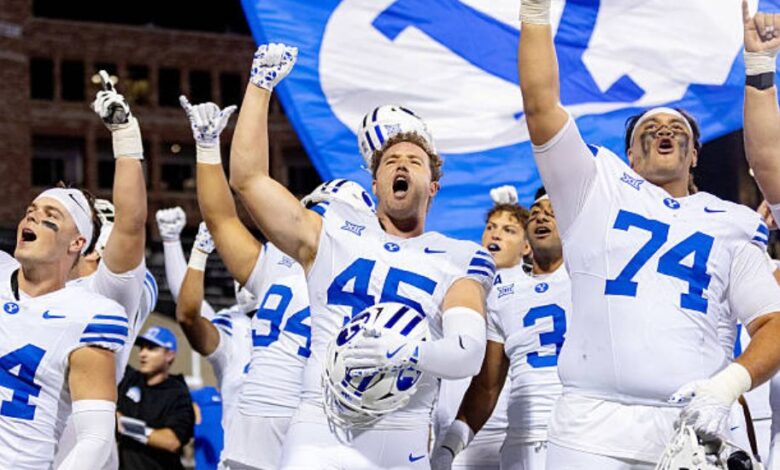BYU Football vs Colorado Buffaloes Football Stats: Complete Game Analysis & Insights

When the BYU Cougars and the Colorado Buffaloes take the field, what looks like another Big 12 matchup is actually a story of contrasting programs, evolving strategies, and statistical truths. Behind every pass, every rushing attempt, and every defensive stand lies a pattern — one that reveals why BYU has had the upper hand and where Colorado has faltered.
This detailed breakdown of the BYU football vs Colorado Buffaloes football stats unpacks recent matchups, key performance metrics, player contributions, and what these numbers mean for both teams moving forward.
Recent Head-to-Head Matchups
December 28, 2024 — Alamo Bowl
In the 2024 Valero Alamo Bowl, BYU dominated Colorado with a final score of 36-14.
Key stats from that game include:
- BYU out-gained Colorado 331 yards to 210 yards.
- On the ground, BYU rushed for 180 yards, while Colorado managed just 2 net rushing yards.
- BYU earned 22 first downs; Colorado had only 9.
- The Cougars ran 65 plays compared to Colorado’s 42, controlling tempo and possession.
- Colorado quarterback Shedeur Sanders completed 16 of 23 passes for 208 yards with 2 touchdowns and 2 interceptions.
- BYU’s running back L.J. Martin led the rushing attack with 93 yards and two touchdowns.
The story of this game was line dominance. BYU controlled both sides of the ball, dictated the pace, and completely neutralized Colorado’s running game. It wasn’t just a win; it was a statement about physicality, discipline, and execution.
September 27, 2025 — Regular Season Game
In their 2025 regular-season meeting in Boulder, BYU again prevailed, winning 24-21.
Key moments and numbers from this matchup:
- Colorado jumped out to an early 14-0 lead in the first quarter.
- BYU rallied with 24 unanswered points before Colorado added a late score.
- BYU quarterback Bear Bachmeier threw for 179 yards and two touchdowns while rushing for another 98 yards.
- BYU wide receiver Chase Roberts caught five passes for 49 yards and two touchdowns.
- The Cougars ran the ball effectively again, with 36 rushes for 208 yards.
- Colorado gained 172 rushing yards on 37 carries but struggled to convert when it mattered most.
The 2025 contest showed growth on both sides. Colorado had early success but struggled with consistency. BYU’s ability to adjust, stay patient, and finish strong highlighted its maturity and tactical depth.
Statistical Themes & Patterns
Ground Game Domination by BYU
In the 2024 Alamo Bowl, BYU’s rushing performance (180 yards) compared to Colorado’s 2 yards was the single most decisive statistic of the game. When a team can’t establish the run, it becomes one-dimensional — and BYU took full advantage.
Running the ball effectively isn’t just about yardage; it’s about control. BYU’s offensive line created lanes, maintained possession, and forced Colorado’s defense into long drives. On the other side, Colorado’s inability to move the chains on the ground left their offense predictable and out of rhythm.
Defensive Prowess & Situational Dominance
BYU’s defense was suffocating. Holding an opponent to 2 rushing yards is almost unheard of at the Power Five level. Beyond that, BYU limited Colorado to nine first downs and 42 total plays. These numbers show not only a talent gap but also a schematic advantage — BYU knew what Colorado wanted to do and took it away.
Defensive success in football often depends on situational execution — third downs, red-zone defense, and turnovers. BYU excelled in all these areas. They consistently forced Colorado into third-and-long situations and capitalized on mistakes.
Colorado’s Fast Starts, BYU’s Strong Finishes
In the 2025 matchup, Colorado came out firing with two quick touchdowns. But from the second quarter onward, BYU made adjustments, controlling possession and wearing down the Buffaloes’ defense.
This pattern — Colorado starting fast but fading — reflects a broader issue with consistency and adaptation. BYU’s steady, composed approach under pressure contrasts sharply with Colorado’s volatile energy.
Head-to-Head Trend & Program Trajectories
Historically, Colorado holds the edge in the all-time series against BYU, but recent matchups have shifted momentum dramatically in BYU’s favor.
The 2024 bowl win and the 2025 regular-season victory represent more than just two wins — they symbolize a philosophical divergence. BYU plays a balanced, disciplined, and physical brand of football. Colorado, though explosive, has often leaned too heavily on star talent rather than team cohesion.
Colorado entered the 2024 bowl with national attention, high-profile transfers, and Heisman buzz around Shedeur Sanders. Yet the stats told another story: 42 offensive plays, 210 total yards, and a run game completely neutralized.
For BYU, those numbers validated their identity — strong fundamentals, patience, and tactical precision.
Breaking Down the Key Metrics
Total Yards & Play Counts
BYU: 331 total yards
Colorado: 210 total yards
A 121-yard difference in total offense, combined with BYU’s 23 additional plays, tells the story of dominance in time of possession and control. When one team runs 50 percent more plays than the other, it’s not just about scoring; it’s about rhythm and fatigue.
Rushing vs. Passing Balance
BYU’s 180 rushing yards contrasted sharply with Colorado’s 2. While Colorado’s passing offense produced some flashes, the lack of ground support made their drives short and unsustainable.
In football, balance is power. BYU’s ability to mix run and pass kept the defense guessing; Colorado’s predictability led to stalled drives.
Third-Down Efficiency
BYU converted 8 of 14 third-down attempts in the bowl game — an impressive 57 percent. Colorado managed very few conversions and was often forced into punting situations. Sustaining drives through third-down conversions is often the hidden key to victory, and BYU’s consistency here was critical.
Quarter-by-Quarter Scoring
In the 2024 bowl game, BYU scored in every quarter:
- 10 points in the 1st
- 10 points in the 2nd
- 7 points in the 3rd
- 9 points in the 4th
Colorado scored just 7 points in each of the last two quarters. The quarter-by-quarter scoring reflects sustained performance — BYU never went scoreless, while Colorado struggled to generate momentum until the game was out of reach.
Special Teams Impact
Special teams are often overlooked, but they played a major role in BYU’s 2024 win. A 64-yard punt return touchdown by Parker Kingston broke the game open, energizing BYU and deflating Colorado’s sideline.
Special teams touchdowns are momentum killers. They flip field position, morale, and momentum — and in this case, reinforced BYU’s dominance across all three phases of the game.
Coaching & Program Implications
BYU’s Rise & Consistency
Under head coach Kalani Sitake, BYU has built a reputation for steadiness and discipline. Their performance against Colorado reflected a team that doesn’t panic, adjusts well, and executes fundamentals at a high level.
Sitake’s leadership has cultivated a culture where every player understands their role, resulting in fewer penalties, efficient drives, and defensive accountability. BYU’s system emphasizes team execution over individual flash — and that’s exactly what separated them from Colorado in both matchups.
Colorado’s Talent vs. Execution
Colorado, led by Deion Sanders, entered the 2024 season as one of the most talked-about programs in college football. They brought in elite transfers, ESPN coverage, and hype unmatched by most mid-tier programs.
However, the statistical reality has lagged behind the headlines. In both 2024 and 2025, Colorado struggled in time of possession, rushing yards, and third-down conversion rates. These aren’t glamorous stats, but they define winning football.
Colorado’s offense is exciting and capable of quick strikes, but without a consistent run game and defensive toughness, they remain vulnerable to grind-it-out teams like BYU.
What the Stats Tell Us About Each Team
BYU: Balanced, Disciplined, and Control-Oriented
- Play Count Advantage: More offensive snaps means more control.
- Ground Game Efficiency: The backbone of BYU’s attack, opening passing lanes and maintaining tempo.
- Defensive Resilience: Consistent ability to stifle opponent rushing attacks.
- Composure: Able to respond to early deficits, as seen in 2025.
BYU’s football identity is built on balance. They rarely rely on just one player; instead, they execute as a unit. Their statistical consistency in rushing, first downs, and turnovers demonstrates a complete team approach.
Colorado: Explosive, Flashy, Yet Inconsistent
- Explosive Starts: Capable of scoring quickly, especially early.
- Limited Sustain: Difficulty maintaining drives and adjusting defensively.
- Heavy Reliance on Stars: When key players are contained, overall performance dips dramatically.
- Defensive Fatigue: High tempo but low time of possession leads to tired defenses late in games.
Colorado’s potential is enormous, but the stats reveal instability. Until they control tempo and become more efficient in possession, their ceiling will be limited.
Contextual Analysis
Timing & Stakes
The 2024 Alamo Bowl wasn’t just another postseason game — it was a national showcase. BYU entered looking to validate its place in the Big 12. Colorado arrived with celebrity buzz and star power. The result: BYU’s statistical domination underlined substance over spectacle.
A year later, the 2025 regular-season meeting reinforced the theme. BYU remained composed; Colorado again flashed brilliance but couldn’t sustain it.
Conference Landscape
Within the Big 12, consistency wins seasons. BYU’s control metrics — possession time, rushing balance, and defensive stops — align with championship-caliber traits. Colorado’s volatility makes them exciting, but also unpredictable.
The data show that BYU’s model — methodical drives, clock control, balanced offense — is better suited for long-term success in the Big 12’s competitive ecosystem.
Statistical Storylines Worth Watching
- Rushing Yard Differential: The 178-yard disparity in the 2024 bowl game will be remembered as one of the most lopsided rushing duels between these teams.
- First Down Gap: BYU’s 22 vs Colorado’s 9 in that same game speaks volumes about offensive consistency.
- Time of Possession: BYU often exceeds 35 minutes per game; Colorado averages around 24. That’s nearly a quarter of football in control difference.
- Turnover Ratio: BYU’s ability to protect the ball while forcing key takeaways continues to define their defensive identity.
- Third-Quarter Performance: Across both games, BYU outscored Colorado 14-0 in the third quarter combined, underscoring superior halftime adjustments.
What Fans and Analysts Can Learn
For fans, these stats help decode the “why” behind wins and losses. It’s not just about spectacular plays — it’s about execution over four quarters.
For analysts, the trends suggest where each program is heading. BYU’s upward trajectory is rooted in fundamentals and efficiency; Colorado’s flash may bring attention, but not always victories.
For recruits, numbers matter. Prospective players see BYU’s stability and player development as attractive. Colorado offers visibility and exposure, but until the wins follow, that allure may fade.
Psychological and Tactical Layers
BYU’s resilience after early deficits (like in 2025) reveals mental toughness — a team that trusts its system. Colorado’s tendency to fade after fast starts hints at emotional volatility or fatigue.
From a tactical standpoint, BYU adjusts mid-game better than almost any Big 12 team. Colorado’s heavy emphasis on explosive plays means that if those plays are neutralized, the offense sputters. This contrast defines their recent meetings.
Lessons in Program Building
- Depth Over Hype: BYU’s roster depth allows rotation without major drop-off. Colorado’s reliance on star power leaves them exposed to injuries or off-days.
- Discipline in Execution: BYU commits fewer penalties and turnovers. The cumulative effect is enormous across a season.
- System Identity: Every great team has one. BYU knows who they are — physical, balanced, unflashy but effective. Colorado is still finding that identity amid celebrity attention.
Future Outlook
If trends continue, BYU looks poised to remain competitive within the Big 12, possibly challenging for top-tier bowl placements. Colorado’s future depends on shoring up its offensive line, improving time of possession, and balancing its play-calling.
As these teams meet again in coming seasons, expect attention on:
- Colorado’s run defense and offensive line development.
- BYU’s evolving quarterback play under Bachmeier.
- Whether Colorado can finally match BYU’s trench strength.
The rivalry could become a defining Big 12 fixture, especially given their contrasting styles — BYU’s methodical control versus Colorado’s explosive unpredictability.
Why These Stats Matter Beyond the Field
Football statistics are not just numbers; they tell stories of preparation, mindset, and adaptability. When a team consistently outruns, out-possesses, and out-executes another, it signals program maturity.
For BYU, the numbers validate a culture built on fundamentals. For Colorado, they serve as a blueprint of what must improve to translate hype into victories.
Each matchup between these two programs provides a microcosm of college football’s wider trends: the battle between structure and star power, between steady progress and flashy promise.
Final Thoughts
When the dust settles and the scoreboard goes dark, the stats remain — and they tell the truth. The BYU Cougars, through balanced offense, strong defense, and strategic control, have established clear superiority over the Colorado Buffaloes in their recent meetings.
Colorado, despite immense talent and media buzz, has yet to translate potential into sustained dominance. The difference lies not in highlight plays, but in efficiency, endurance, and adaptability.
The data don’t lie: BYU executes with purpose; Colorado dazzles with moments. For now, execution wins.
The next time BYU and Colorado meet, remember these numbers — they’ll forecast the outcome long before the final whistle.
Thank you for reading this comprehensive breakdown of the BYU Football vs Colorado Buffaloes Football Stats, presented by Newsta — your trusted source for deep sports insights and analysis.



